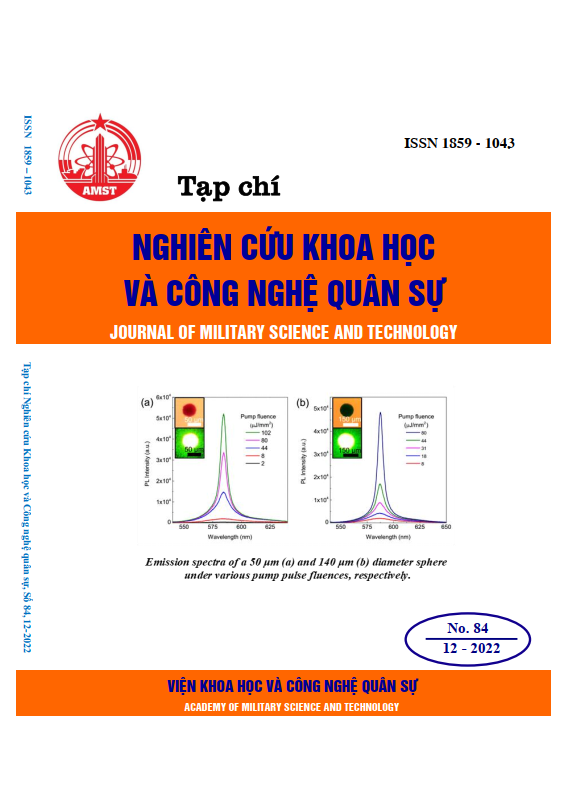Random lasers based on inverse photonic glass structure
612 viewsDOI:
https://doi.org/10.54939/1859-1043.j.mst.84.2022.127-132Keywords:
Random laser; Inverse photonic glass; Microspheres.Abstract
Random laser has attracted much attention because of its unique physical properties and potential applications in lighting, speckle-free imaging, biosensing, and photonic devices. In this work, we confirm that scattering plays a vital role in random lasing. Then, we investigate lasing properties of random film lasers with two scattering structures, including polystyrene
microparticles and air voids embedded in a polymer matrix with organic dye serving as a gain medium. These two structures are called direct and inverse photonic glass, respectively. The result indicates that random lasers based on inverse photonic glass have a lower threshold. Following this achievement, we implemented inverse photonic glass into microspheres to obtain
random microlasers of different sizes. Our work shows that inverse photonic glass structure is an excellent medium for random lasers with a wide range of sizes and dimensions. Especially, the obtained random microlasers are promising for applications in microsensors and photonic integrated circuits.
References
[1]. Luan F, Gu B, Gomes ASL, Yong K-T, Wen S, Prasad PN. "Lasing in nanocomposite random media". Nano Today, Vol. 10, pp. 168-192, (2015). DOI: https://doi.org/10.1016/j.nantod.2015.02.006
[2]. Cao H. "Lasing in random media". Waves in Random Media, Vol. 13, pp. R1-R39, (2003). DOI: https://doi.org/10.1088/0959-7174/13/3/201
[3]. Wiersma DS, Lagendijk A. "Light diffusion with gain and random lasers". Physical Review E, Vol. 54, pp. 4256-4265, (1996). DOI: https://doi.org/10.1103/PhysRevE.54.4256
[4]. Cao H, Zhao YG, Ho ST, Seelig EW, Wang QH, Chang RPH. "Random Laser Action in Semiconductor Powder". Physical Review Letters, Vol. 82 , pp. 2278-2281, (1999). DOI: https://doi.org/10.1103/PhysRevLett.82.2278
[5]. Chen R, Ye Q-L, He T, Ta VD, Ying Y, Tay YY, et al. "Exciton Localization and Optical Properties Improvement in Nanocrystal-Embedded ZnO Core–Shell Nanowires". Nano Letters, Vol. 13, pp. 734-739, (2013). DOI: https://doi.org/10.1021/nl304433m
[6]. Polson RC, Vardeny ZV. "Random lasing in human tissues". Applied Physics Letters, Vol. 85, pp. 1289-1291, (2004). DOI: https://doi.org/10.1063/1.1782259
[7]. Siddique M, Yang L, Wang QZ, Alfano RR. "Mirrorless laser action from optically pumped dye-treated animal tissues". Optics Communications, Vol. 117, pp. 475-479, (1995). DOI: https://doi.org/10.1016/0030-4018(95)00176-9
[8]. Caixeiro S, Gaio M, Marelli B, Omenetto FG, Sapienza R. "Silk-Based Biocompatible Random Lasing". Advanced Optical Materials, Vol. 4, pp. 998-1003, (2016). DOI: https://doi.org/10.1002/adom.201600185
[9]. Ta VD, Caixeiro S, Saxena D, Sapienza R. "Biocompatible Polymer and Protein Microspheres with Inverse Photonic Glass Structure for Random Micro-Biolasers". Advanced Photonics Research, Vol. 2, pp. 2100036, (2021). DOI: https://doi.org/10.1002/adpr.202100036
[10]. Ta VD, Saxena D, Caixeiro S, Sapienza R. "Flexible and tensile microporous polymer fibers for wavelength-tunable random lasing". Nanoscale, Vol. 12, pp. 12357-12363, (2020). DOI: https://doi.org/10.1039/D0NR02484H
[11]. Ta VD, Nguyen Thiet V, Pham Quan V, Nguyen Toan V. "Biocompatible microlasers based on polyvinyl alcohol microspheres". Optics Communications, Vol. 459, pp. 124925, (2020). DOI: https://doi.org/10.1016/j.optcom.2019.124925
[12]. Sha WL, Liu CH, Alfano RR. "Spectral and temporal measurements of laser action of Rhodamine 640 dye in strongly scattering media". Optics Letters, Vol. 19, pp. 1922-1924, (1994). DOI: https://doi.org/10.1364/OL.19.001922
[13]. Wiersma D. "The smallest random laser". Nature, Vol. 406, pp. 133-135, (2000). DOI: https://doi.org/10.1038/35018184







